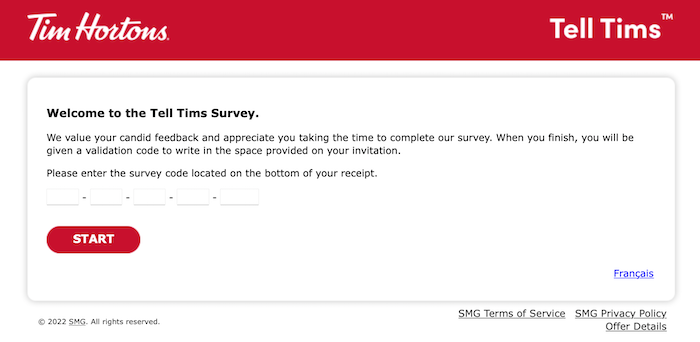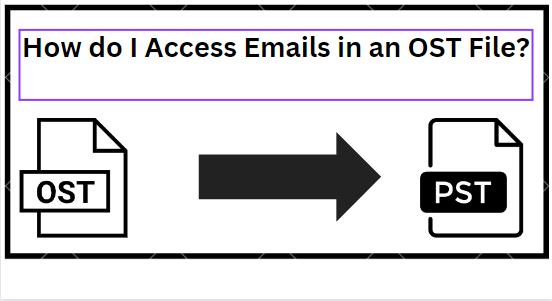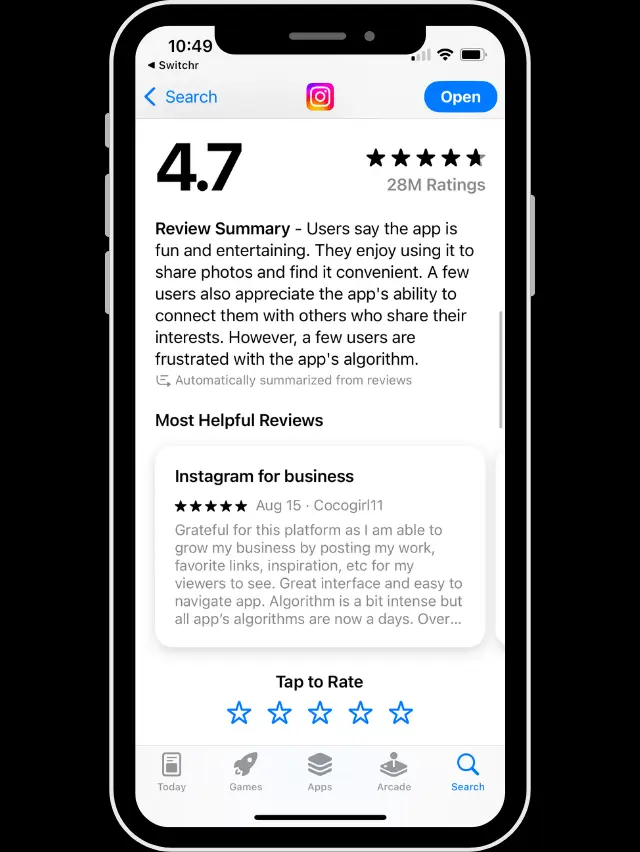How To Build A Facebook Ads Dashboard In Google Data Studio via @sejournal, @andreaatzori
Looking for more robust Facebook Ads reporting? Learn how to build a Google Data Studio dashboard with this step-by-step process. The post How To Build A Facebook Ads Dashboard In Google Data Studio appeared first on Search Engine Journal.
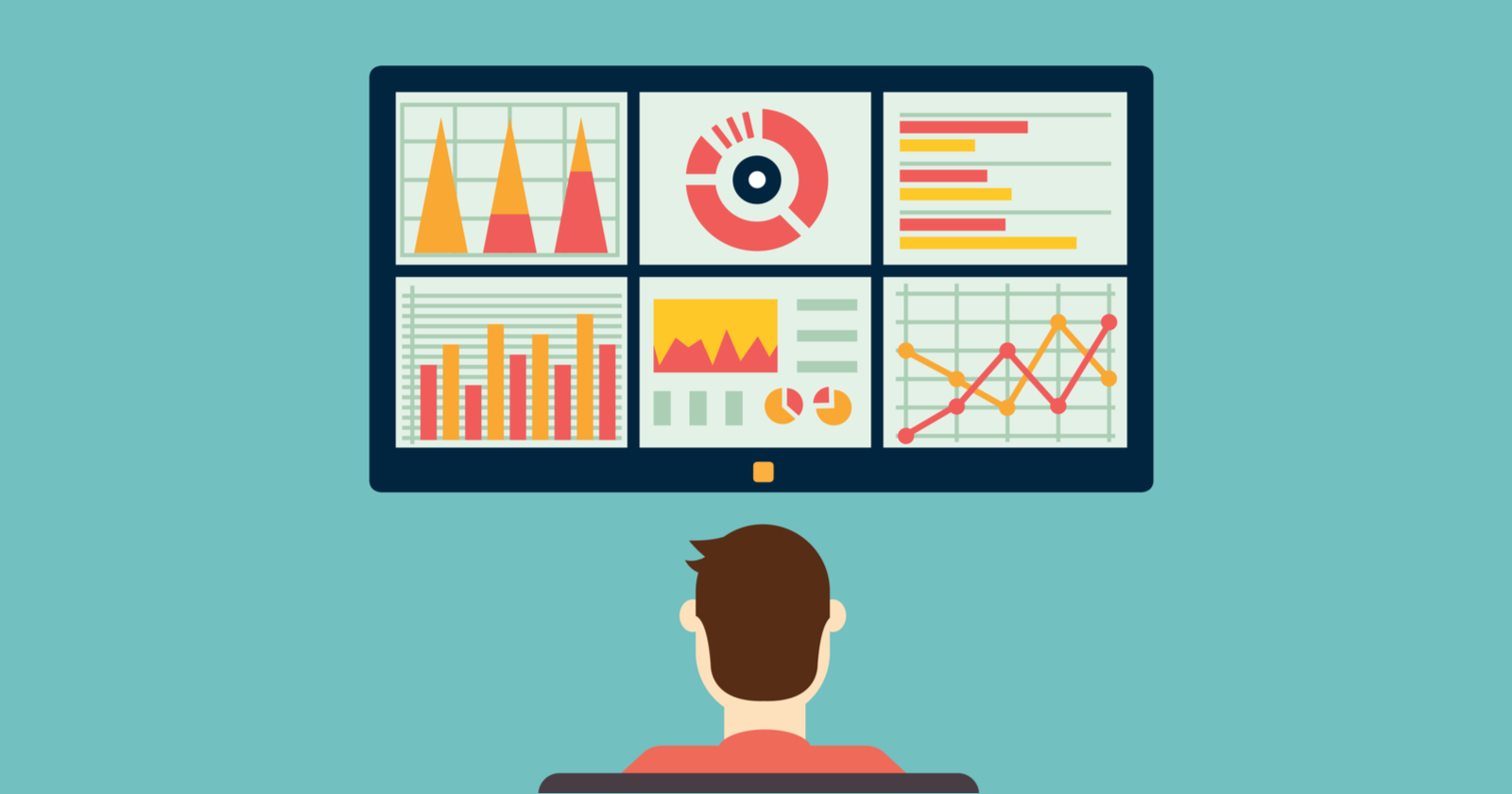
Facebook Ads are an important part of many businesses’ digital marketing strategies.
Whether the objective is to build awareness or generate sales and revenue, measuring and reporting on campaign efficacy can be challenging.
You may wonder, are my Facebook Ads working? Or should I invest my marketing budget elsewhere?
The Facebook Ads platform allows you to create reports with data sliced and diced in many different ways, providing great insights into the ads’ performance.
However, Facebook Ads reporting can be overwhelming and confusing.
Even a simple dashboard can help you raise the bar and elevate your reporting to a new level.
In this column, you’ll learn how to do just that using a Google Data Studio dashboard for your Facebook Ads performance reporting.
Why You Need A Facebook Ads Dashboard
There is no lack of reporting solutions out there, but Google Data Studio, in our opinion, tops the list.
It’s easy to use, fast, and most importantly, it’s free.
There are also several additional benefits, starting with your ability to natively import data from Google Analytics.
That means you can measure the effectiveness of your Facebook campaigns and compare how they do against the performance of other channels.
Additionally, a dashboard enables you to easily manipulate the data and present it in multiple reports or charts.
But that’s not all. From the user perspective, dashboards are much easier to manage than reports when analyzing and comparing data sets and/or date ranges.
How To Get Started With Google Data Studio And Facebook Ads
While Google Data Studio is an amazing tool in the digital marketer’s arsenal, integrating Facebook Ads data requires a few additional steps compared to Google’s native platforms such as Google Ads, Google Analytics, etc.
Fear not. Countless manual and automated solutions allow you to import the data from Facebook Ads into Data Studio.
Whichever you choose, you should still be able to achieve a beautiful and valuable dashboard for you and your business.
Importing The Data Manually
Let’s start with a manual import of the data.
1. Exporting The Data
The easiest way to get this underway is to create a downloadable report in Facebook Ads.
Be aware that if you want to measure the success of your ads by platform (i.e., Facebook, Instagram, etc.) and/or placement (Instagram Stories, Feed, Right Hand Column, etc.) you will not be able to see metrics such as Purchases, Purchases Conversion Value, or Cost per purchase.
That level of data is not available on the (Facebook Ads) platform, so it is also not accessible through the data no matter how you pull it, whether via the API, a connector, or manually downloaded as in our case.
Conversion data is only available at the top level.
If you want to see how your ads perform and measure their ROI (return on investment) or ROAS (return on ad spend), you will need to download the data broken down by Campaign, Ad Set, and/or time – only.
You can still create and download an additional report that breaks the data down by delivery and, therefore, Platform and Placement.
However, that will only show you performance metrics such as Impressions, Reach, Clicks, CPC (cost-per-click), CPM (cost-per-thousand impressions), etc.
There is still a great case for using this data to evaluate and understand the performance of our ads across each platform and placement, and to use those lessons to optimize the campaign delivery.
Step 1: Head to Ads reporting and create a new report.
 Screenshot from Facebook Ads Manager, June 2022
Screenshot from Facebook Ads Manager, June 2022
Step 2: Choose the metrics and dimensions for your report.
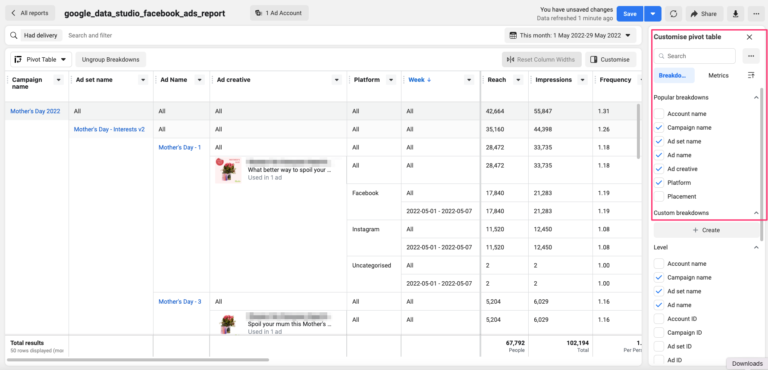 Screenshot from Facebook Ads Manager, June 2022
Screenshot from Facebook Ads Manager, June 2022
Here, it’s important that you have the final outcome in mind and what data you will require for the dashboard.
Step 3: Schedule the report.
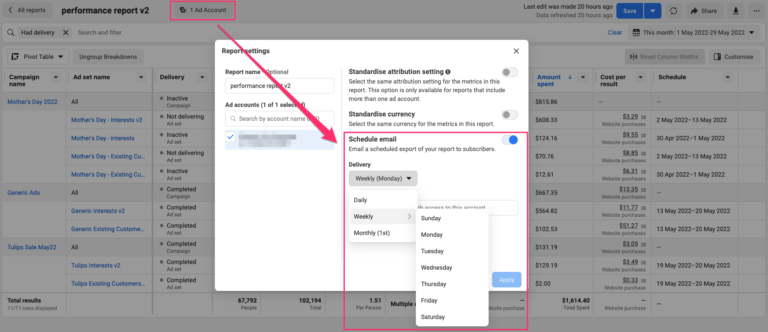 Screenshot from Facebook Ads Manager, June 2022
Screenshot from Facebook Ads Manager, June 2022
This is optional, but getting the reports sent to your inbox instead of downloading them every single time will make your life much easier!
Step 4: You might need to manipulate the data.
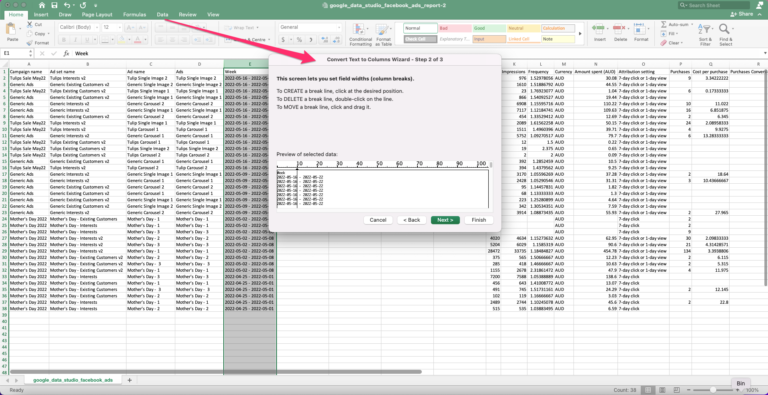 Screenshot from author, June 2022
Screenshot from author, June 2022
Aligning the data downloaded from Facebook Ads might require some small changes.
In our example above, we changed the date column to ensure that Google Data Studio would recognize it.
2. Importing The Data
Once you download the data in a CSV or Excel format, you can import it into Google Sheets.
Step 5: From Excel to Google Sheets.
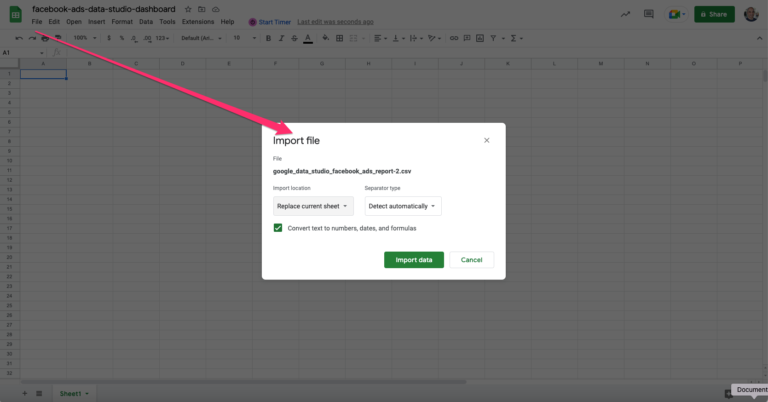 Screenshot from Google Sheets, June 2022
Screenshot from Google Sheets, June 2022
If you have scheduled the report to be emailed regularly, whether daily, weekly, or monthly, you can automate some of the steps above.
Solutions like Zapier allow you to set up auto-imports of the data from the email attachment directly into Google Sheets.
Since this can be different from setup to setup, we won’t cover that process in this guide. However, a quick Google search should help.
After you import the data, connect the sheet to Data Studio as a data source.
Step 6: Add the data.
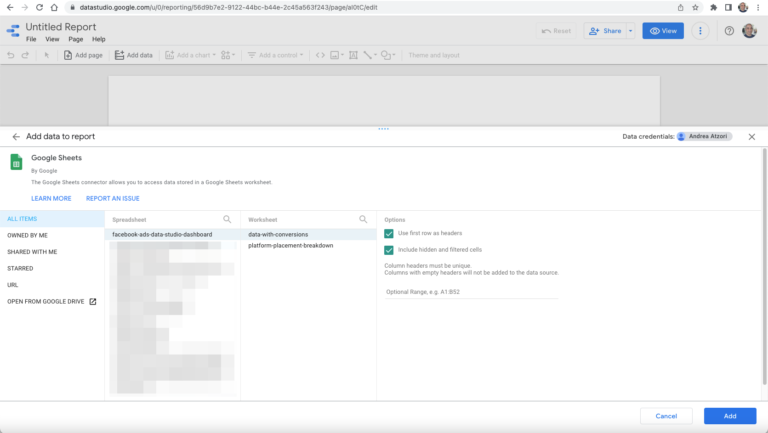 Screenshot from Google Data Studio, June 2022
Screenshot from Google Data Studio, June 2022
You will only need to connect the Google Sheet to the Data Studio Dashboard once.
Once connected, any changes to the data in the sheet will be reflected in the dashboard.
When adding data to Data Studio from a CSV or Google Sheets, note some really important things.
Treat metrics such as reach and frequency and calculated metrics such as CPC, CPM, etc., carefully when combining and aggregating the data.
More on that in a few minutes. In the meantime, we can start designing and building our dashboard.
Designing And Building The Dashboard
Step 7: Start adding some design and feature elements.
 Screenshot from Google Data Studio, June 2022
Screenshot from Google Data Studio, June 2022
We added a logo and date range control in our example and made them “report-level.”
That means that these elements will be copied across all of the pages of our dashboard, which can be very handy!
From here on, the options are endless.
Step 8: Change theme, add the data with scorecards and tables, visualize it with charts, and more.
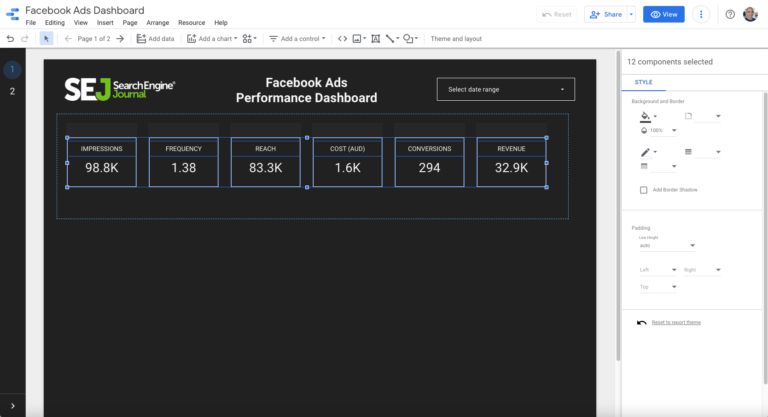 Screenshot from Google Data Studio, June 2022
Screenshot from Google Data Studio, June 2022
We started with a few scorecards to show top-line performance and KPIs in our example.
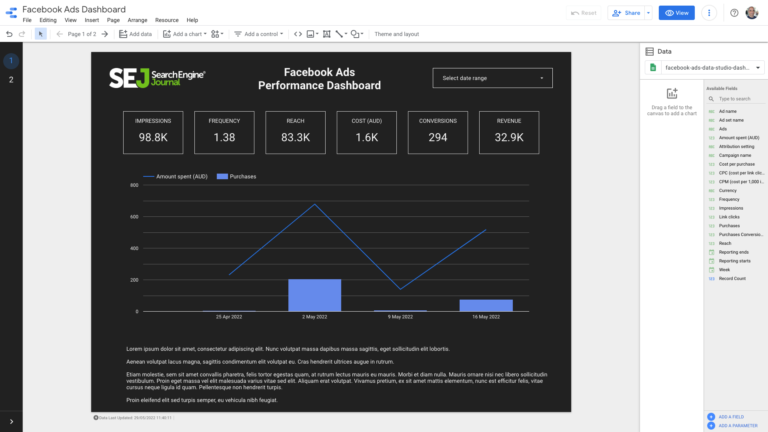 Screenshot from Google Data Studio, June 2022
Screenshot from Google Data Studio, June 2022
You can also add free text to include commentary, insights, and recommendations.
Step 9: Add additional features to your dashboard.
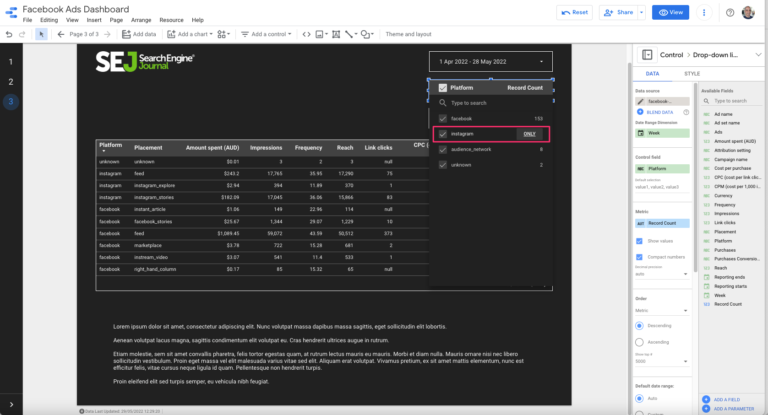 Screenshot from Google Data Studio, June 2022
Screenshot from Google Data Studio, June 2022
You can now customize your pages and how you access the data with filters, segments, sliders, drop-down lists, and more.
Going back to our example, the screenshot above shows how using drop-down lists makes it possible to zoom into subsets of data.
Here, we can choose to segment it by platform (i.e., Instagram, Facebook, etc.).
Rinse And Repeat
And there you have it – the basic steps to create a Data Studio dashboard for your Facebook Ads.
It is that easy.
You can add new data sources, bring additional datasets into the report, and create even more granular and advanced reports within your dashboards.
Metrics Such As Reach And Frequency
As mentioned above, some metrics need to be managed carefully.
For example, if we have a report that includes the frequency of the ads broken down by week, neither the sum nor average of those values will give you the accurate number as it would be reported on the Facebook Ads platform or reports.
I suggest downloading and adding the data for the period you would like to report on and adding it as a separate sheet (or tab if included in the existing report).
Calculated Metrics
For values like average click-through-rate, CPC, CPM, or even ROI (return on investment) and ROAS, I suggest adding these as metrics calculated within Data Studio.
Doing so is simple.
In the metrics, select Add Metric, Create Field, and there you can build your values.
Note that this is not limited to just these simple metrics, but you can also create and add your own metrics.
 Screenshot from Google Data Studio, June 2022
Screenshot from Google Data Studio, June 2022
For instance, you could add values such as Gross Profit Margin or other financial metrics that allow you to better understand how your business is performing in relation to the Facebook advertising, and straight from within the dashboard!
Connectors And Automation
It’s easy and quick to create an integrated solution that relies on manually downloading the data or setting up a workflow that uses tools like Zapier.
However, there are also more advanced options.
These are particularly useful for agencies and large-scale businesses that need to minimize manual tasks and favor full automation for reliability (i.e., reducing the margin of error) and speed, especially when working with large datasets.
For this purpose, our company uses Dataslayer (though there are others, too), a reporting tool that provides a powerful and easy-to-use Google Sheets connector.
The benefit is that you can create and save queries in your sheet with the connector and, once they’re set, can automatically pull the data and refresh it regularly.
So, for example, we could set the query to download the data every Monday for the previous seven days and therefore have the Data Studio dashboard automatically refreshed and updated every week – without having to lift a finger.
Final Considerations
As we have seen, creating a useful dashboard requires a bit of planning and work to set up.
But the beauty of it is that dashboards (as a collection of reports and charts) are extremely powerful and flexible by nature.
Don’t be afraid to start with a simple version and keep creating multiple iterations of it with different views, tables, charts, and more.
The time and efforts invested will be more than worth it!
More resources:
New Google Blog Series About Search Console & Data Studio How To Unlock Better Google Data Studio Segments Using “CASE” How to Advertise on Facebook: A Beginner’s GuideFeatured Image: Griboedov/Shutterstock

 UsenB
UsenB 








![10 Creative Infographics & Why They Work [With Examples] via @sejournal, @alexanderkesler](https://cdn.searchenginejournal.com/wp-content/uploads/2022/04/image-for-guest-article-SEJ_1600x840_-1.png)



